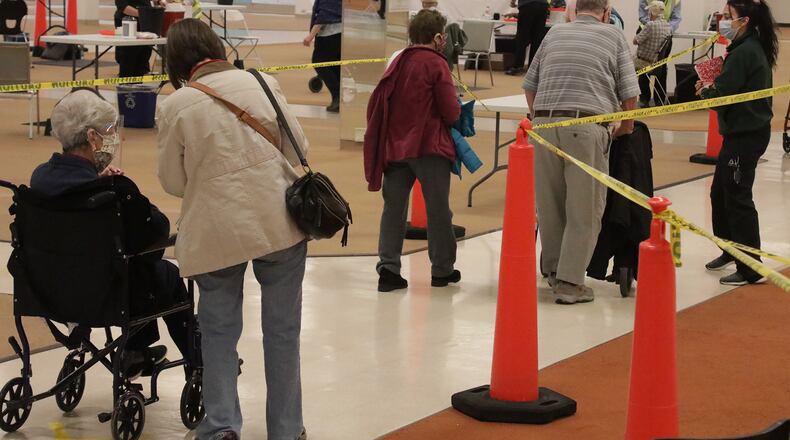“The unfortunate part is we have an operation where we could easily do 1,000 plus vaccines in a day and we are only going to get 500 doses (next week),” Clark County Combined Health District Commissioner Charles Patterson said. “We can hardly even run a clinic with 500 doses.”
As of Thursday afternoon, Clark County had given at least one dose of the COVID-19 vaccine to 50.1% of those 80 years old or older in the county, according to ODH. That makes the county one of eight counties in the state that have vaccinated at least 50% or more of the age group.
Gallia County leads the state with 56.2%, followed by Delaware (53.9%) Union (52.5%), Fulton (51.9%), Muskingum (50.8%), Crawford (50.6%) and Mercer (50.1%).
“We have been very, very, very busy. But it’s a good busy because we are actually making some people happy here,” Clark County Combined Health District Commissioner Charles Patterson said. “We have spent the last nine months telling people ‘no you have to stay home,’ ‘no you can’t do this,’ and now for once we’re able to come out and say ‘yes, come out and get your vaccine.’”
Patterson said he believes there are two primary reasons why Clark County has been able to vaccinate so many within this age group. The first is the health district’s partnerships with the Springfield Regional Medical Center, which has allowed the two organizations to combine vaccine supplies.
Springfield Regional was among the first 10 hospitals in Ohio to receive the first shipment of the Pfizer COVID-19 vaccine in mid-December. The shipment contained 975 doses of vaccine that were slated to be given to health care personnel.
Because of that pre-positioning, Patterson said, the county was able to get a jump start on vaccine preparation.
“That pre-positioning at the hospital put us at an advantage here,” Patterson said. “We didn’t have to scramble at the beginning.”
The second advantage, Patterson said, is the health district’s scheduling and quick turn around time.
“We got 1,950 Pfizer doses on Monday. By (Thursday), those will be gone,’' he said last week. “When we get the doses on Monday, we schedule clinics on Tuesday, Wednesday and Thursday and then they are gone,” Patterson said. “We don’t hold them another week or two until we have time. We schedule them and we get them done.”
Gov. Mike DeWine released the vaccination schedule for Phase 1b, a group that includes Ohioans ages 65 and older, K-12 school staff and those with severe medical issues, about a month ago. Those ages 80 and older began receiving vaccinations on Jan. 19, with the state extending the age group to receive the vaccine by five years each week from then on.
Clark County residents 70 and older will become eligible for the vaccine starting Monday.
As of Thursday, 9,120 vaccination shots have been given out in total Clark County, according to ODH. That’s about 6,80% of the county’s total population.
The health district isn’t the only vaccine provider in Clark County. As of Thursday, the county had six providers, with two new providers, CVS and Walgreens, slated to onboard next week.
In the first week of Phase 1b rollout, the county and its providers received a total of 1,800 doses of vaccine. Last week, they received 2,750.
Kyle Trout, the communications coordinator for the CCCHD, said the health district doesn’t know the total number of vaccines that will be sent to providers this week as some are “on a different list.” However, the health district and SRMC are expected to receive roughly 500 doses combined.
“Our teams are doing an exemplary job of good customer experience. But we are just a little depressed with our allocation being cut by 75%,” Patterson said.
Vaccine supply is likely to remain scarce for weeks or months at a national level, thus supply is scarce in Ohio, because producing biological products like the coronavirus vaccine is a challenge and scaling up production isn’t easy, Mark Jacobs, a professor who teaches supply chain management at the University of Dayton College of Business said.
“Even once production is successfully brought to full scale, yields can be variable until the process is fully refined,” Jacobs said.
Some of the ingredients needed to make the vaccine have never before been produced at the sheer volume needed. And factories can’t transition to creating new kinds of vaccines overnight.
Moderna and Pfizer say they are each on track to deliver 100 million doses to the U.S. by the end of March and another 100 million in the second quarter of the year. Both Moderna’s and Pfizer’s vaccines, the only two which are federally approved so far, require two doses taken four and three weeks apart respectively.
DeWine said this week there will be an uptick in supply heading to Phase 1b recipients as Phase 1a recipients finish up with their second doses. He also said another 77,000 doses will become available in the next two weeks because the state will no longer be setting as many doses aside for nursing homes.
On average, according to DeWine, Ohio is receiving 146,000 first doses of the two-dose vaccine regimen every week. And as Phase 1a finishes, between 110,000 and 120,000 of those doses will then move to Phase 1b recipients.
Patterson said he understands people’s frustration about the vaccine shortage but believes ”everyone from the federal government to the state government to the local governments are doing the best that they can.”
“Vaccine is vaccine. You can’t just get it out of the air,” Patterson said.
In an effort to keep the county’s vaccination numbers high — while doses coming into the county are low — Patterson encourages all residents who qualify for a vaccine under Phase 1b to “vaccine shop” at all of the county’s vaccine providers.
The county’s providers include the health district, all three Springfield-area Kroger pharmacies, Rocking Horse Community Health Center and Discount Drug Mart.
“We aren’t the only player in town. We are all taking part in moving the community to the next phase of this COVID-19 response,” Patterson said.
But Patterson said that as soon as residents schedule an appointment, the shopping should stop.
“Pick one as soon as you get your appointment. If you have an appointment, that means that you have your name on a vaccine and you are going to get it,” Patterson said. “When you schedule an appointment then make another one and cancel it, you are basically holding someone else back from getting their appointment at that time.”
For more information about where and how to schedule a vaccination in Clark County, visit the health district’s website (ccchd.com).
Clark County had 11,205 cases of the coronavirus as of Thursday afternoon, according to ODH. The county also had 273 deaths and 13 probable deaths, according to data from the CCCHD.
Staff Writer Jordan Laird contributed to this report.
About the Author

